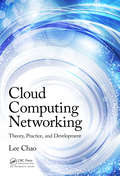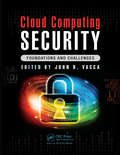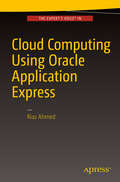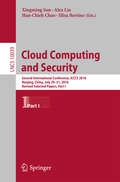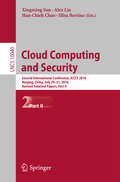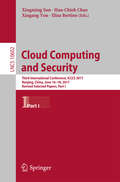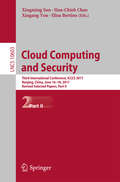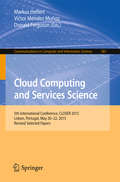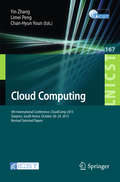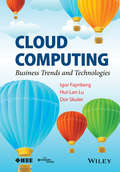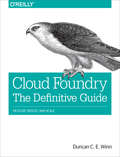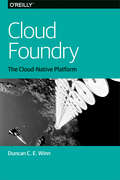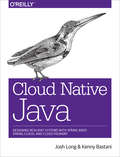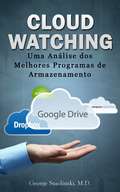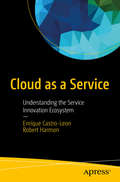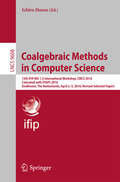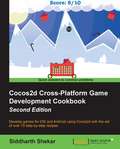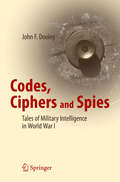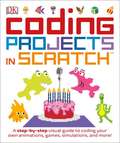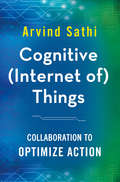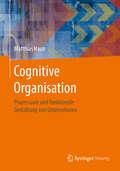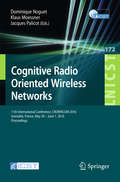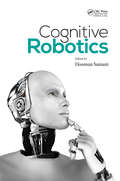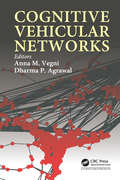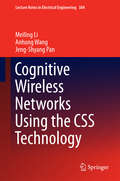- Table View
- List View
Cloud Computing Networking: Theory, Practice, and Development
by Lee ChaoCloud computing is the most significant technology transformation since the introduction of the Internet in the early 1990s. This book covers the key networking and system administration concepts as well as the vital hands-on skills you need to master cloud technology. It is designed to help you quickly get started in deploying cloud services for a real-world business. It provides detailed step-by-step instructions for creating a fully functioning cloud-based IT infrastructure using Microsoft Azure. The book enhances your hands-on skills through numerous lab activities.
Cloud Computing Security: Foundations and Challenges
by John VaccaThis handbook offers a comprehensive overview of cloud computing security technology and implementation, while exploring practical solutions to a wide range of cloud computing security issues. With more organizations using cloud computing and cloud providers for data operations, proper security in these and other potentially vulnerable areas have become a priority for organizations of all sizes across the globe. Research efforts from both academia and industry in all security aspects related to cloud computing are gathered within one reference guide.
Cloud Computing Using Oracle Application Express
by Riaz AhmedDevelop cloud-based applications rapidly using the Oracle Application Express (APEX) platform. You will learn to develop a comprehensive functional business application which can be deployed in your organization. Cloud Computing Using Oracle Application Express will teach you how to develop a complete general ledger accounting system which will be accessible through a variety of devices, including desktops, laptops, and the latest smartphones. What You Will Learn: Use new Oracle APEX 5. 0 techniques Develop a complete general ledger accounting system named The Cloud Accountant Develop cloud-based business apps accessible anywhere and anytime Enhance your APEX development skills Who This Book Is For: Web developers who possess some working knowledge of Oracle Application Express, and developers who have been using Oracle Forms and now wish to use their existing SQL and PL/SQL expertise.
Cloud Computing and Security: Second International Conference, ICCCS 2016, Nanjing, China, July 29-31, 2016, Revised Selected Papers, Part I (Lecture Notes in Computer Science #10039)
by Alex Liu Elisa Bertino Xingming Sun Han-Chieh ChaoThis two volume set LNCS 10039 and LNCS 10040 constitutes the thoroughly refereed post-conference proceedings of the Second International Conference on Cloud Computing and Security, ICCCS 2016, held in Nanjing, China, during July 29-31, 2016. The 97 papers of these volumes were carefully reviewed and selected from 272 submissions. The papers are organized in topical sections such as: Information Hiding, Cloud Computing, Cloud Security, IOT Applications, Multimedia Applications, Multimedia Security and Forensics.
Cloud Computing and Security: Second International Conference, ICCCS 2016, Nanjing, China, July 29-31, 2016, Revised Selected Papers, Part II (Lecture Notes in Computer Science #10040)
by Alex Liu Elisa Bertino Xingming Sun Han-Chieh ChaoThis two volume set LNCS 10039 and LNCS 10040 constitutes the thoroughly refereed post-conference proceedings of the Second International Conference on Cloud Computing and Security, ICCCS 2016, held in Nanjing, China, during July 29-31, 2016. The 97 papers of these volumes were carefully reviewed and selected from 272 submissions. The papers are organized in topical sections such as: Information Hiding, Cloud Computing, Cloud Security, IOT Applications, Multimedia Applications, Multimedia Security and Forensics.
Cloud Computing and Security: Third International Conference, ICCCS 2017, Nanjing, China, June 16-18, 2017, Revised Selected Papers, Part I (Lecture Notes in Computer Science #10602)
by Elisa Bertino Xingming Sun Han-Chieh Chao Xingang YouThis two volume set LNCS 10039 and LNCS 10040 constitutes the thoroughly refereed post-conference proceedings of the Second International Conference on Cloud Computing and Security, ICCCS 2016, held in Nanjing, China, during July 29-31, 2016. The 97 papers of these volumes were carefully reviewed and selected from 272 submissions. The papers are organized in topical sections such as: Information Hiding, Cloud Computing, Cloud Security, IOT Applications, Multimedia Applications, Multimedia Security and Forensics.
Cloud Computing and Security: Third International Conference, ICCCS 2017, Nanjing, China, June 16-18, 2017, Revised Selected Papers, Part II (Lecture Notes in Computer Science #10603)
by Elisa Bertino Xingming Sun Han-Chieh Chao Xingang YouThis two volume set LNCS 10039 and LNCS 10040 constitutes the thoroughly refereed post-conference proceedings of the Second International Conference on Cloud Computing and Security, ICCCS 2016, held in Nanjing, China, during July 29-31, 2016. The 97 papers of these volumes were carefully reviewed and selected from 272 submissions. The papers are organized in topical sections such as: Information Hiding, Cloud Computing, Cloud Security, IOT Applications, Multimedia Applications, Multimedia Security and Forensics.
Cloud Computing and Services Science: 5th International Conference, CLOSER 2015, Lisbon, Portugal, May 20-22, 2015, Revised Selected Papers (Communications in Computer and Information Science #581)
by Markus Helfert Donald Ferguson Víctor Méndez MuñozThis book constitutes the thoroughly refereed proceedings of the 5th International Conference on Cloud Computing and Services Science, CLOSER 2015, held in Lisbon, Portugal, in May 2015. The 14 revised full papers presented together with one invited paper were selected from 146 paper submissions. The papers focus on the following topics: cloud computing fundamentals; services science foundations for cloud computing; cloud computing platforms and applications; cloud computing enabling technologies; and mobile cloud computing services.
Cloud Computing: 6th International Conference, CloudComp 2015, Daejeon, South Korea, October 28-29, 2015, Revised Selected Papers (Lecture Notes of the Institute for Computer Sciences, Social Informatics and Telecommunications Engineering #167)
by Yin Zhang Limei Peng Chan-Hyun YounThis book constitutes the proceedings of the 6th International Conference on Cloud Computing, CloudComp 2015, held in Daejeon, South Korea, in October 2015. The 36 revised full papers were carefully reviewed and selected from 89 submissions and cover topics such as virtualization and management on cloud; resource management, models and performance; mobile cloud and media services; pervasive cloud applications, services and testbeds; cloud-enabling techniques and devices.
Cloud Computing: Business Trends and Technologies
by Igor Faynberg Hui-Lan Lu Dor SkulerCloud Computing: Business Trends and Technologies provides a broad introduction to Cloud computing technologies and their applications to IT and telecommunications businesses (i.e., the network function virtualization, NFV). To this end, the book is expected to serve as a textbook in a graduate course on Cloud computing.The book examines the business cases and then concentrates on the technologies necessary for supporting them. In the process, the book addresses the principles of – as well as the known problems with – the underlying technologies, such as virtualization, data communications, network and operations management, security and identity management. It introduces, through open-source case studies (based on OpenStack), an extensive illustration of lifecycle management.The book also looks at the existing and emerging standards, demonstrating their respective relation to each topic.Overall, this is an authoritative textbook on this emerging and still-developing discipline, which•Guides the reader through basic concepts, to current practices, to state-of-the-art applications.•Considers technical standards bodies involved in Cloud computing standardization.•Is written by innovation experts in operating systems and data communications, each with over 20 years’ experience in business, research, and teaching.
Cloud Foundry: Develop, Deploy, and Scale
by Duncan C. E. WinnHow can Cloud Foundry help you develop and deploy business-critical applications and tasks with velocity? This practical guide demonstrates how this open source, cloud-native application platform not only significantly reduces the develop-to-deploy cycle time, but also raises the value line for application operators by changing the way applications and supporting services are deployed and run. Learn how Cloud Foundry can help you improve your product velocity by handling many of essential tasks required to run applications in production.Author Duncan Winn shows DevOps and operations teams how to configure and run Cloud Foundry at scale. You’ll examine Cloud Foundry’s technical concepts—including how various platform components interrelate—and learn how to choose your underlying infrastructure, define the networking architecture, and establish resiliency requirements.This book covers:Cloud-native concepts that make the app build, test, deploy, and scale fasterHow to deploy Cloud Foundry and the BOSH release engineering toolchainConcepts and components of Cloud Foundry’s runtime architectureCloud Foundry’s routing mechanisms and capabilitiesThe platform’s approach to container tooling and orchestrationBOSH concepts, deployments, components, and commandsBasic tools and techniques for debugging the platformRecent and soon-to-emerge features of Cloud Foundry
Cloud Foundry: The Cloud-Native Platform
by Duncan C. E. WinnWhat exactly is a cloud-native platform? It’s certainly a hot topic in IT, as enterprises today assess this option for developing and delivering software quickly and repeatedly. This O’Reilly report explains the capabilities of cloud-native platforms and examines the fundamental changes enterprises need to make in process, organization, and culture if they’re to take real advantage of this approach.Author Duncan Winn focuses on the open source platform Cloud Foundry, one of the more prominent cloud-native providers. You’ll learn how cloud-native applications are designed to be "infrastructure unaware" so they can thrive and move at will in the highly distributed and constantly evolving cloud environment.With this report, you’ll explore:Technical driving forces that are rapidly changing the way organizations develop and deliver software todayHow key concepts underpinning the Cloud Foundry platform leverage each of the technical forces discussedHow cloud-native platforms remove the requirement to perform undifferentiated heavy lifting, such as provisioning VMs, middleware, and databasesWhy cloud-native platforms enable fast feedback loops as you move from agile development to agile deploymentRecommended changes and practical considerations for organizations that want to build cloud-native applications
Cloud Native Java: Designing Resilient Systems with Spring Boot, Spring Cloud, and Cloud Foundry
by Josh Long Kenny BastaniWhat separates the traditional enterprise from the likes of Amazon, Netflix, and Etsy? Those companies have refined the art of cloud native development to maintain their competitive edge and stay well ahead of the competition. This practical guide shows Java/JVM developers how to build better software, faster, using Spring Boot, Spring Cloud, and Cloud Foundry.Many organizations have already waded into cloud computing, test-driven development, microservices, and continuous integration and delivery. Authors Josh Long and Kenny Bastani fully immerse you in the tools and methodologies that will help you transform your legacy application into one that is genuinely cloud native.In four sections, this book takes you through:The Basics: learn the motivations behind cloud native thinking; configure and test a Spring Boot application; and move your legacy application to the cloudWeb Services: build HTTP and RESTful services with Spring; route requests in your distributed system; and build edge services closer to the dataData Integration: manage your data with Spring Data, and integrate distributed services with Spring’s support for event-driven, messaging-centric architecturesProduction: make your system observable; use service brokers to connect stateful services; and understand the big ideas behind continuous delivery
Cloud Watching
by Hugo Martins George SmolinskiOrganizar e armazenar informações sempre foi uma precupação da humanidade desde os tempos antigos e continuará sendo, pois é inerente a natureza humana. Com o advento do Armazenamento Virtual, a forma como lidamos em manter tais informações seguras e organizadas mudou incrivelmente, tornando-se fundamental adaptar-se a esta nova era da tecnologia. E para entender e usar esta tecnologia é que, com grande satisfação, tive o prazer de colaborar na publicação, em português, do livro do Dr. George Smolinski. Sua simplicidade, e a sua efetividade, em elucidar as características e utilização dos principais serviços disponíveis atualmente, faz desta obra ter uma importância singular no meio de tantos outros materias disponíveis.
Cloud as a Service: Understanding the Service Innovation Ecosystem
by Enrique Castro-Leon Robert HarmonSee how the principles of Service Science govern the dynamics driving the adoption of cloud computing in the industry.Cloud as Service shows you how the evolution of enterprise computing platforms to application-specific cloud platforms (ASCPs) have aligned to business needs. You'll also learn processes for developing and building ASCPs. You'll gain insight into how executives, managers, and technologists are utilizing cloud services, cloud service providers, equipment manufacturers, and software and application vendors participating in cloud supply chains.For business, the appeal of cloud computing must go beyond the notion of convenient, on-demand access of networked pooled access to computing resources. Industry leaders have learned to apply cloud computing to become more nimble, cost effective, and customer engaging as they strive for competitive advantage, regardless of size. These companies define and build cloud platforms customized for their needs rather than using someone else’s. This book shows you how to use a holistic, end-to-end view of platform planning, platform development, supply chains and operations to collapse platform development times to a fraction of the original time. You’ll see that strategies for selling to the cloud market are essentially incomplete; and that in order to be successful, businesses must become cloud service businesses themselves, incorporating cloud technologies in their engineering, IT, sales and marketing, and delivery processes. What You'll Learn:Historical perspective to provide insight into the dynamics driving cloud evolution todayState of the art in IT requirements and cloud solutionsThe value of User Experience (UX) driven design principlesThe crucial roles of Service Brokers and Service Assurance ManagersThe landscape of emerging cloud services and what they mean to your enterpriseService Portals and Enterprise Service BusesWho This Book Is For:CIOs, CTOs, data center architects, solution architects and application engineers Educational institutions building a systems integration curriculum Developers who want to understand how their work fits in the cloud ecosystem
Coalgebraic Methods in Computer Science: 13th IFIP WG 1.3 International Workshop, CMCS 2016, Colocated with ETAPS 2016, Eindhoven, The Netherlands, April 2-3, 2016, Revised Selected Papers (Lecture Notes in Computer Science #9608)
by Ichiro HasuoThis book constitutes the thoroughly refereed post-conference proceedings of the 13th International Workshop on Coalgebraic Methods in Computer Science, CMCS 2016, colocated with ETAPS 2016, held in Eindhoven, The Netherlands, in April 2016. The 10 revised full papers were carefully reviewed and selected from 13 submissions. Also included are an invited paper and two keynote talks. The papers cover a wide range of topics in the theory, logics and applications of coalgebras.
Cocos2d Cross-Platform Game Development Cookbook - Second Edition
by Siddharth ShekarDevelop games for iOS and Android using Cocos2d with the aid of over 70 step-by-step recipes About This Book * Learn to efficiently use Cocos2d to develop cross-platform games, and have them work on iOS as well as Android * Get acquainted with industry-wide professional tools such as Glyph Designer, Texture Packer, and Physics Editor, as well as using the Swift/ Sprite builder implementation of Cocos2d * Use the easy-to-follow recipes to develop as well as deploy games to the Playstore and the App Store Who This Book Is For This book is for intermediate game developers and especially the ones who are generally curious to find out what's new in Cocos2d v 3.3. What You Will Learn * Build custom sprites with custom animations for the game * Build interactivity into your game by adding gestures and touch interactions * Understand AI enemy programming and path finding to make games more exciting * Add physics to your game to make it more lively and interactive * Get familiar with the Swift and Sprite builder implementations along with Objective-C programming * Perform hassle-free deployment of games built in iOS onto Android * Add effects and particle systems to make the game more colorful In Detail Cocos2d is the world's leading game development framework for developing iOS games. With the introduction of Swift and Spritebuilder, it has become easier than ever to develop the games of your dreams without much effort. With Cocos2d, you can also deploy the game on Android, thereby maximizing profit and reducing development and porting costs. The book starts off with a detailed look at how to implement sprites and animations into your game to make it livelier. You will then learn to add scenes to the game such as the gameplay scene and options scene and create menus and buttons in these scenes, as well as creating transitions between them. From there on, you will get an understanding of how to program user interactions such as tapping, holding, and swiping. You'll then add accelerometer inputs and physics to the scene, and make objects respond back to the inputs. A game is practically incomplete without audio being added, so this will be covered next. The next section will include ways to add Artificial Intelligence to enemies in the game, allowing them to patrol, chase, and shoot in a projectile manner. You will then learn to use NSUserDefault to save and load game progress, and create and access files using JSON, Plist, and XML files for custom storage and retrieval of data. Then you will learn to add dynamic lighting to your game and will use industry-wide tools such as Texture Packer, Glyph Designer, Physics Editor, Particle Designer, and Sprite Illuminator to create more visually appealing and performance-optimized games. Towards the end of the book, we dive into Apple's latest programming language--Swift, highlighting the major differences between Objective C and Swift. The book culminates with taking your existing game developed for iOS and porting it to Android, showing you how to install the Android Xcode plugin as well. Style and approach The book is written in an extremely lucid and step-by-step manner; it can be understood easily by anyone. The topics included are broken down into individual chapters so you can refer to the specific chapter to get answers on the subject you are interested in.
Codes, Ciphers and Spies: Tales of Military Intelligence in World War I
by John F. DooleyWhen the United States declared war on Germany in April 1917, it was woefully unprepared to wage a modern war. Whereas their European counterparts already had three years of experience in using code and cipher systems in the war, American cryptologists had to help in the building of a military intelligence unit from scratch. This book relates the personal experiences of one such character, providing a uniquely American perspective on the Great War. It is a story of spies, coded letters, plots to blow up ships and munitions plants, secret inks, arms smuggling, treason, and desperate battlefield messages. Yet it all begins with a college English professor and Chaucer scholar named John Mathews Manly. In 1927, John Manly wrote a series of articles on his service in the Code and Cipher Section (MI-8) of the U. S. Army's Military Intelligence Division (MID) during World War I. Published here for the first time, enhanced with references and annotations for additional context, these articles form the basis of an exciting exploration of American military intelligence and counter-espionage in 1917-1918. Illustrating the thoughts of prisoners of war, draftees, German spies, and ordinary Americans with secrets to hide, the messages deciphered by Manly provide a fascinating insight into the state of mind of a nation at war.
Coding Projects In Scratch
by Dorling Kindersley Publishing Staff Jon WoodcockA straightforward, visual guide that shows young learners how to build their own computer projects using Scratch, a popular free programming language, using fun graphics and easy-to-follow instructions. <p><p> Kids can animate their favorite characters, build games to play with friends, create silly sound effects, and more with Coding Projects in Scratch. All they need is a desktop or laptop with Adobe 10.2 or later, and an internet connection to download Scratch 2.0. Coding can be done without download on https://scratch.mit.edu. <p> Step-by-step instructions teach essential coding basics and outline 18 fun and exciting projects, including a personalized birthday card; a "tunnel of doom" multiplayer game; a dinosaur dance party animation with flashing lights, music, and dance moves--and much more. <p> The simple, logical steps in Coding Projects in Scratch are fully illustrated with fun pixel art and build on the basics of coding, so that kids can have the skills to make whatever kind of project they can dream up. <p> Supporting STEM education initiatives, computer coding teaches kids how to think creatively, work collaboratively, and reason systematically, and is quickly becoming a necessary and sought-after skill. DK's computer coding books are full of fun exercises with step-by-step guidance, making them the perfect introductory tools for building vital skills in computer programming.
Cognitive (Internet of) Things: Collaboration to Optimize Action
by Arvind SathiThis book explores cognitive behavior among Internet of Things. Using a series of current and futuristic examples - appliances, personal assistants, robots, driverless cars, customer care, engineering, monetization, and many more - the book covers use cases, technology and communication aspects of how machines will support individuals and organizations. This book examines the Cognitive Things covering a number of important questions: * What are Cognitive Things? * What applications can be driven from Cognitive Things - today and tomorrow? * How will these Cognitive Things collaborate with each and other, with individuals and with organizations? * What is the cognitive era? How is it different from the automation era? * How will the Cognitive Things support or accelerate human problem solving? * Which technical components make up cognitive behavior? * How does it redistribute the work-load between humans and machines? * What types of data can be collected from them and shared with external organizations? * How do they recognize and authenticate authorized users? How is the data safeguarded from potential theft? Who owns the data and how are the data ownership rights enforced? Overall, Sathi explores ways in which Cognitive Things bring value to individuals as well as organizations and how to integrate the use of the devices into changing organizational structures. Case studies are used throughout to illustrate how innovators are already benefiting from the initial explosion of devices and data. Business executives, operational managers, and IT professionals will understand the fundamental changes required to fully benefit from cognitive technologies and how to utilize them for their own success.
Cognitive Organisation: Prozessuale und funktionale Gestaltung von Unternehmen
by Matthias HaunDie in dem Buch beschriebenen Methoden und Techniken sichern Unternehmen den Entwicklungsvorsprung, der ben#65533;tigt wird, um mit hoher Innovations- und Zukunftssicherheit in organisatorischer und technologischer Hinsicht auf dynamischen M#65533;rkten zu bestehen. Der innovative Ansatz stellt die Begriffe Kognition, Organisation, Wissen und Technologie in den Mittelpunkt. Mit Hilfe der wissensbasierten, handlungsorientierten und simulationsvalidierten Methodik k#65533;nnen innovative Unternehmen als kognitive, wandelbare Organisationen entwickelt werden.
Cognitive Radio Oriented Wireless Networks: 11th International Conference, CROWNCOM 2016, Grenoble, France, May 30 - June 1, 2016, Proceedings (Lecture Notes of the Institute for Computer Sciences, Social Informatics and Telecommunications Engineering #172)
by Jacques Palicot Dominique Noguet Klaus MoessnerThis book constitutes the thoroughly refereed conference proceedings of the 11th International Conference on Cognitive Radio Oriented Wireless Networks, CROWNCOM 2016, held in Grenoble, France, May 30 - April 1, 2016. The 62 revised full papers presented were carefully reviewed and selected from numerous submissions and cover the evolution of cognitive radio technology pertaining to 5G networks. The papers are clustered to topics on dynamic spectrum access/management, networking protocols for CR, modeling and theory, HW architecture and implementations, next generation of cognitive networks, standards and business models, emerging applications for cognitive networks.
Cognitive Robotics
by Hooman SamaniThe kimono-clad android robot that recently made its debut as the new greeter at the entrance of Tokyo's Mitsukoshi department store is just one example of the rapid advancements being made in the field of robotics.Cognitive robotics is an approach to creating artificial intelligence in robots by enabling them to learn from and respond to real-worl
Cognitive Vehicular Networks
by Anna Maria Vegni Dharma P. AgrawalA comprehensive text on both current and emerging areas of cognitive vehicular networks, this book focuses on a new class of mobile ad hoc networks. It uses a pedagogical approach utilizing cognitive aspects applied to vehicular environments and comprises contributions from well-known and high profile researchers in their respective specialties. The book provides significant technical and practical insights on different perspectives, starting from a basic background on cognitive radio, interrelated technologies, application to vehicular networks, technical challenges, and future trends.
Cognitive Wireless Networks Using the CSS Technology (Lecture Notes in Electrical Engineering #384)
by Jeng-Shyang Pan Anhong Wang Meiling LiThe aim of this book is to provide someuseful methods to improve the spectrum sensing performance in a systematic way,and point out an effective method for the application of cognitive radiotechnology in wireless communications. The book gives a a state-of-the-artsurvey and proposes some new cooperative spectrum sensing (CSS) methodsattempting to achieve better performance. For each CSS, the main idea andcorresponding algorithm design are elaborated in detail. This book covers the fundamental concepts and the coretechnologies of CSS, especially its latest developments. Each chapter ispresented in a self-sufficient and independent way so that the reader canselect the chapters interesting to them. The methodologies are described indetail so that the readers can repeat the corresponding experiments easily. It will be a useful book for researchers helping them tounderstand the classifications of CSS, inspiring new ideas about the novel CSStechnology for CR, and learning new ideas from the current status of CSS. Forengineers, it will be a good guidebook to develop practical applications forCSS.
